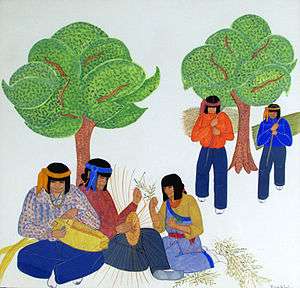Casein paint

Casein paint, derived from milk casein (milk protein), is a fast-drying, water-soluble medium used by artists.
Description
It generally has a glue-like consistency, but can be thinned with water to the degree that fits a particular artist's style and desired result. It can be used on canvas panels, illustration boards, paper, wood and masonite. Because the dried paint film is inflexible and brittle, it is not appropriate to be applied in heavy impastos on flexible supports such as canvas. Canvas laminated to board is more suitable. Casein paint is reworkable and can be used for underpainting. It generally dries to a matte finish.
Uses
Casein paint has been used since ancient Egyptian times as a form of distemper paint, and is still used today. One of the qualities that artists value casein paint for is that, unlike gouache, it dries to an even consistency, making it ideal for murals. Also, visually it can resemble oil painting more than most other water-based paints, and works well as an underpainting.
Casein paint loses its solubility with time and exposure and becomes water-resistant. It is suited most to inflexible surfaces, including furniture.[1] It can be buffed to a soft velvet finish when dry, or varnished for a gloss finish.
Medium
A quick way to make casein painting medium is to take some skim milk cottage cheese and first wash off any of the milky fluids. The lumps of casein left behind are then dissolved by adding, in a pot, water and some ammonia. The ammonia should be preferably in the form of ammonium carbonate. As the mixture is stirred while it warms it begins to froth and the lumps dissolve. It is not boiled but kept simmering and stirred until the frothing stops. After the syrup is cooled, that is the medium. It looks like white school glue or heavy cream.[2] It keeps in a refrigerator for about four days.
Casein artists
Yantonai Dakota artist Oscar Howe of South Dakota used casein extensively.
Santa Clara Pueblo artist Pablita Velarde created a series of more than 70 paintings of everyday Native American life in New Mexico for Bandelier National Monument between 1937 and 1943, painted mostly on masonite using casein paints.
Casein was widely used by commercial illustrators as the material of choice until the late 1960s when, with the advent of acrylic paint, casein became less popular. Dick Tracy (1960), and Popeye (1960), two early paintings by Andy Warhol, who had been a commercial illustrator before becoming a fine artist, were painted with casein.